#bony fish
Text

Leopard-spotted goby
By: Douglas P. Wilson
From: The Fascinating Secrets of Oceans & Islands
1972
#goby#gobiiform#bony fish#fish#1972#1970s#Douglas P. Wilson#The Fascinating Secrets of Oceans & Islands
37 notes
·
View notes
Text

Bluemask Darter (Etheostoma akatulo), male, family Percidae, order Perciformes, Tennessee, USA
ENDANGERED.
photograph by isaac szabo
4K notes
·
View notes
Text
Wet Beast Wednesday: moray eels
This week on Wet Beast Wednesday I'll be going over something amazing, a fish with a sense of morality. You see, the moral eel is known for, what... I think I'm reading this wrong. Oh, MoRAY eel, not moral. Well this is awkward. Hang tight, I need to go redo my research.

(Image: a green moray (Gymnothorax funebris) swimming outside of its burry, with its whole body visible from the side. It is a long, slender fish that looks a bit like a snake. A long fin starts just below the head and continues down the length of the body. The body is arranged in a wave pattern. It has a pointed snout and small eyes. Its body is a yellow-green color. In the background is the sandy seafloor, dotted with various sponges and corals. End ID)
Moray eels are true eels, meaning they are in the order Anguiliformes. Yeah, I did wolf eels, electric eels, and lamprey eels before I got around to actual eels. There are over 200 known species of moray eel in 15 genera. Like other eels, they are elongated bony fish with extra vertebrae and reduced fins. Moray eels have fewer fins than most eel species, only having a dorsal, anal and tail fin that merge together and run down the back of most of the body and underneath portion of it. They achieve motion by undulating this long fin and sometimes undulating the rest of the body as well. Moray eels aren't the fastest of fish, but they can swim backwards, something almost no fish can. The head has a long snout with wide jaws. Most species have long fangs used to grab onto prey, but a few species are adapted to eat hard-shelled prey and have molar-like teeth to crush through shells instead. Probably the coolest feature of morays are the pharyngeal jaws. This is a second set of jaws located in the back of the mouth. When the eel bites onto prey, the jaws can be shot forward to grab the food and help pull it into the throat. While lots of fish have pharyngeal jaws, morays are the only ones who can extend their pharyngeal jaws forward and use them to grab prey. Morays have smooth, scaleless skin that is often patterned to provide camouflage. The skin is coated in mucus that provides protection from damage and infection. In some species, the mucus can be used to glue sand together to help reinforce burrows. Morays lack lateral lines, a system of organs found in most fish that senses changes in water movement. Their sense of smell is their primary sense. The size of morays varies between species. The smallest species is the dwarf moray eel (Gymnothorax melatremus) which reaches 26 cm (10 in) long. The largest species by mass is the giant moray eel (Gymnothorax javanicus) which can reach 3 meters (10 ft) and 30 kg (66 lbs) while the longest species is the slender giant moray (Strophidon sathete), the longest known specimen of which measured in at 3.94 m (12.9 ft).

New reaction image
(Image: a giant moray (Gymnothorax javanicus) emerging from a burrow. It is brown and mottled with yellowish patches. Its head is pointed at the camera and it's mouth is wide open, aming it look shocked. End ID)

(Image: an anatomical diagram of the skeleton of a moray eel emphasizing the pharyngeal jaws and the muscle attachments. End ID. Art by Zina Deretsky)
Moray eels are found throughout the Atlantic, Pacific, and Indian oceans. Different species are found in different temperatures and depths, though most species live in relatively shallow, warm water. Several species can live in brackish water and a few will swim upriver and live for a time in fresh water, though there do not appear to be any species that live their entire lives in fresh water. Morays are ambush predators who rely on the element of surprise. They live in small, tight places such as holes in coral, gaps between rocks, or sandy burrows. When prey passes, the eel can lunge out and grab it. Unlike most fish, the eel cannot use suction feeding due to the shapes of their mouths. They have to rely on lunging froward and catching prey with their mouths. Their mouths are adapted in shape to push water to the sides. This reduces water resistance and avoids creating a wave that could push prey away from the eel. If an eel catches prey that cannot be swallowed whole, it will tie itself in a knot while biting on to the food. By pulling its head through the loop, the eel can rip the food into bite-sized pieces. Spending most of their times in burrows also provides protection from predators, especially in juveniles or smaller species. At night, the eels will come out of their burrows to hunt sleeping prey while the larger predators are asleep. Giant morays have also been seen engaging in interspecies cooperative hunting with roving coral groupers (Plectropomus pessuliferus). The eels can fit into small crevices the groupers can't to flush prey into the grouper's path while catching their own. Morays are mostly solitary species and many can be territorial. They are known to be shy and will retreat into their burrows if they feel threatened. They are also curious and many species are quite intelligent.
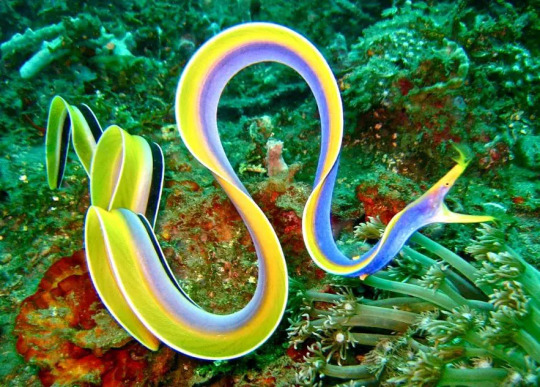
(Image: a male ribbon eel (Rhinomuraena quaesita) on a coral reef. It is a very long and slender eel with its body curved in many waves. It is brightly colored, with a blue-purple body, yellow fin and face, and a long black and white stripe running down the back half of the body. On the nostrils are two feather-like structures. End ID)
Morays reproductive strategies are poorly known and differ based on species. While many species seem to have no set mating season and will reproduce whenever they can, others will mate at the same time every year. Some species seem to have dedicated spots to lay their eggs and a few are believed to be anadromous, meaning they travel from the sea to fresh water to spawn. Meanwhile, some of the species that spend a lot of time in fresh water are catadromous, meaning they return to sea to mate. Females will lay their eggs and the male fertilize them. After this, they depart, providing no parental care. As with all true eels, moray eels begin life as leptocephalus larvae. This type of fish larvae is notable for its resemblance to a simple, transparent leaf with a head on one end. These larvae are unique and poorly understood, despite being the larval stage of a lot of different species of fish. They are unusually well developed for larvae, capable of active swimming and generally living life. In fact, some particularly large leptocephalus larvae were initially mistaken for adult fish. They feed mostly on bits of drifting organic material called marine snow and can remain in the larval stage for up to 3 years, with those in colder conditions usually taking longer to metamorphose. All leptocephalus larvae start out with no sex organs, then develop female organs, then develop male ones, becoming simultaneous hermaphrodites. They will ultimately become eith male or female and it is likely that environmental factors are the main determining factor. During metamorphosis into a juvenile, the leptocephalus can reduce in size by up to 90%, resulting in the juvenile being smaller than the larva. The process of maturation is poorly understood, but it seems that most morays will be sexually mature by three years of age.

(Image: multiple photos of a particularly large leptocephalus larva (not sure what species). It is a translucent organis, wth a body shaped like a very long leaf, narrow at both ends. In the frint is a very tiny head. End ID)
Morays are shy and generally avoid humans. Though some cultures have hunted them for food, they are often not considered a particularly good food source. Many species have high levels of chemicals called ciguatoxins in their bodies, which can lead to a condition called ciguatera fish poisoning if eaten. The largest threat to morays is habitat loss. This is especially true for the many species that live in coral reefs, which are in increasing danger due to global warming. Attacks on humans are rare and usually happen as a response to a human sticking their hand in the eel's burrow. Some of the large species could cause significant damage with a bite. Some species, usually the smaller ones, are found in the aquarium trade, thought they are not good pets for beginners as even the smallest morays are still large for aquarium fish and have some specific requirements. The curiosity many morays have has led to some becoming familiar with and even friendly to humans, often the result of feeding them. They can recognize individual humans and remember them over the course of years. Aquarium employees sometimes report that the eels will come to nuzzle and play with them and have personalities like dogs. Marine biologists and professional SCUBA divers Ron and Valorie Taylor befriended a pair of eels they named Harry and Fang at the Great Barrier Reef who would remember them and come out to visit them year after year.
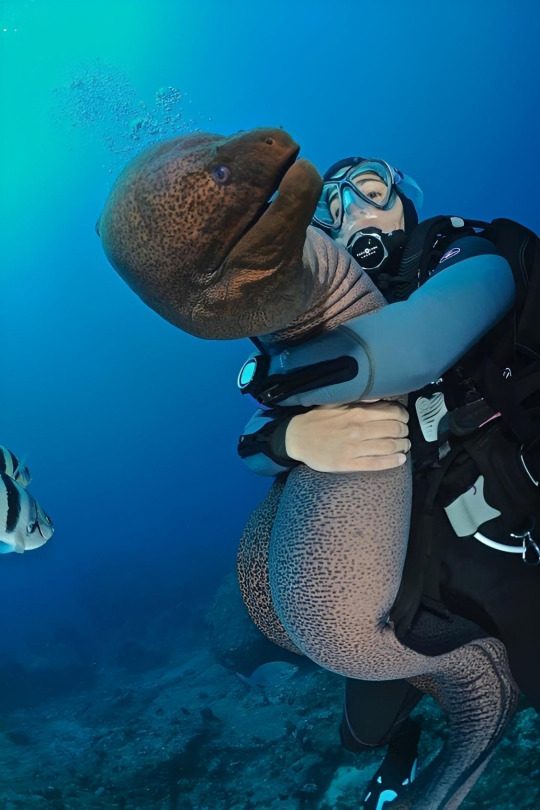
(Image: a SCUBA diver hugging a large, brown moray with black spots. End ID)
youtube
(Video: A shot video showing Valeria Taylor and a moray eel she befriended)
youtube
(Video: the song "That's a Moray", a parody of the song "That's Amore" by Dean Martin)
#wet beast wednesday#i accidentally typed moron eel more than once#moray eel#eel#anguiliformes#fish#bony fish#fishblr#fishposting#eelposting#marine biology#biology#ecology#zoology#animal facts#informative#image described#that's a moray#educational#Youtube
649 notes
·
View notes
Text
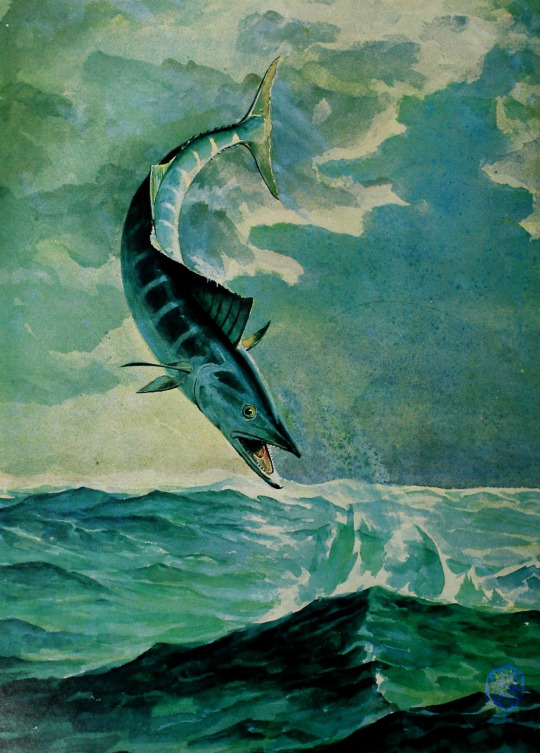
Wahoo, Frank Stick. Wildlife in North Carolina. September 1981.
Internet Archive
1K notes
·
View notes
Text
Uncharismatic Fact of the Day
Often hailed as beautiful and powerful, lumpsucker fish have many talents; one important skill they lack, though, is swimming. Lumpsucker bodies are almost perfectly round, which isn't very hydrodynamic. On top of that, they lack a swim bladder-- an organ that other fish use to control their bouyancy. As a result, lumpsuckers spend most of their lives suctioned onto rocks or coral.
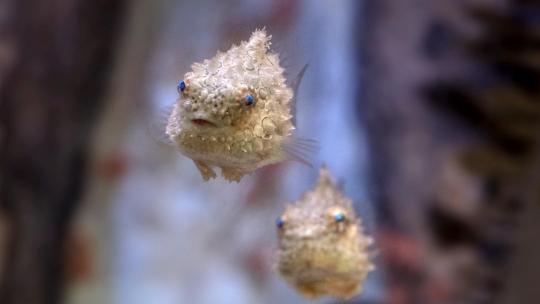
(Image: A pair of Pacific spiny lumpsickers (Eumicrotremus orbis) by the Shedd Aquarium)
If you like what I do, consider leaving a tip or buying me a ko-fi!
#pacific spiny lumpsucker#Scorpaeniformes#Cyclopteridae#lumpsuckers#ray finned fish#bony fish#fish#uncharismatic facts
474 notes
·
View notes
Text
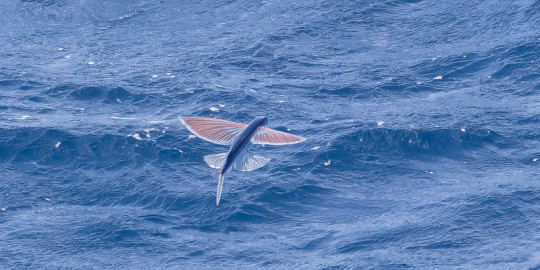
A flying fish (Exocoetidae sp.) takes off near the Cape Verde islands, Africa
by Harold Moses
#flying fish#bony fish#fish#exocoetidae#Beloniformes#actinopterygii#chordata#wildlife: cabo verde#wildlife: africa
463 notes
·
View notes
Text
Okay fish fans, let's settle this.
Oh, tell me your favourite fish too! I wanna know ^^
#fish#bony fish#ray-finned fish#cartilaginous fish#cartilaginous#jawless fish#polls#marine biology#my polls
281 notes
·
View notes
Text

Wimple Piranha (Catoprion mento)
Family: Serrasalmid Family (Serrasalmidae)
IUCN Conservation Status: Least Concern
A tiny (15cm/5.9 inches in length) relative of the more famous Red-Bellied Piranha, the Wimple Piranha is found in the Amazon, Orinoco, Paraguay and Essequibo river basins, and is notable for its unusual diet; adults of this species feed almost exclusively on fish scales, feeding by ramming into larger fish at high speeds with their mouths wide open, biting and generating suction to dislodge their target’s scales and pull them into their mouths. The practice of eating scales, known as lepidophagy, is rare in animals as scales are difficult to digest and require considerable amounts of energy to obtain, and it is likely that it developed in response to the intense competition between fish species in the biodiverse rivers to which Wimple Piranhas are native - although their nutrients-poor diet limits their size, feeding exclusively on scales (occasionally supplemented by small insects or small amounts of the meat of their otherwise unharmed targets where possible) allows Wimple Piranhas to find food while largely avoiding competing with larger and less specialised carnivores. Besides their unusual feeding habits little is known about the biology of wild Wimple Piranhas, although through the observation of captive individuals it has been found that unlike many piranha species they are solitary (possibly avoiding living in groups to avoid competing with other members of their species,) and that like other members of their family females of this species lay eggs.
--------------------------------------------------------------------------
Image Source: https://www.inaturalist.org/taxa/342485-Catoprion-mento
#Wimple Piranha#piranha#piranhas#fish#fishes#zoology#biology#icthyology#animal#animals#wildlife#South American wildlife#freshwater fish#bony fishes#bony fish#aquatic wildlife#evolution#ecology
102 notes
·
View notes
Text
trout and salmon earrings for all of my freshwater fish girlies (gender-neutral) out there!! salmon are anadromous but still lol!! really really loved working on the coho salmons the most.
I’ve got an Etsy shop opening up by the end of this year with lots more fun fishy things to come! be on the look out for some saltwater fish earrings coming soon >:}
insta: @eel.mania <3
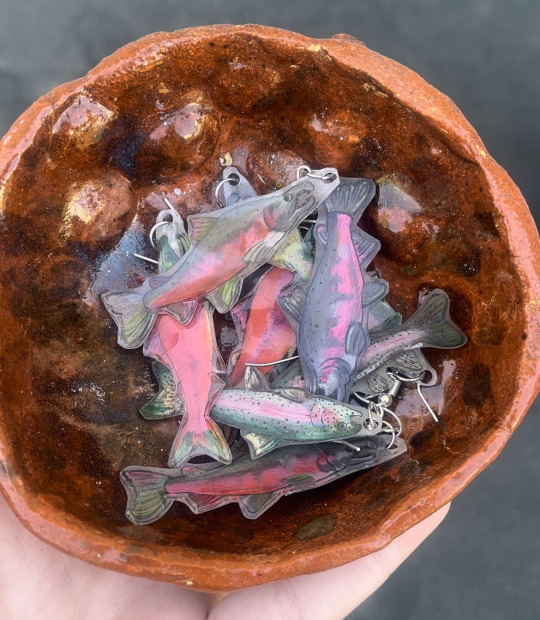
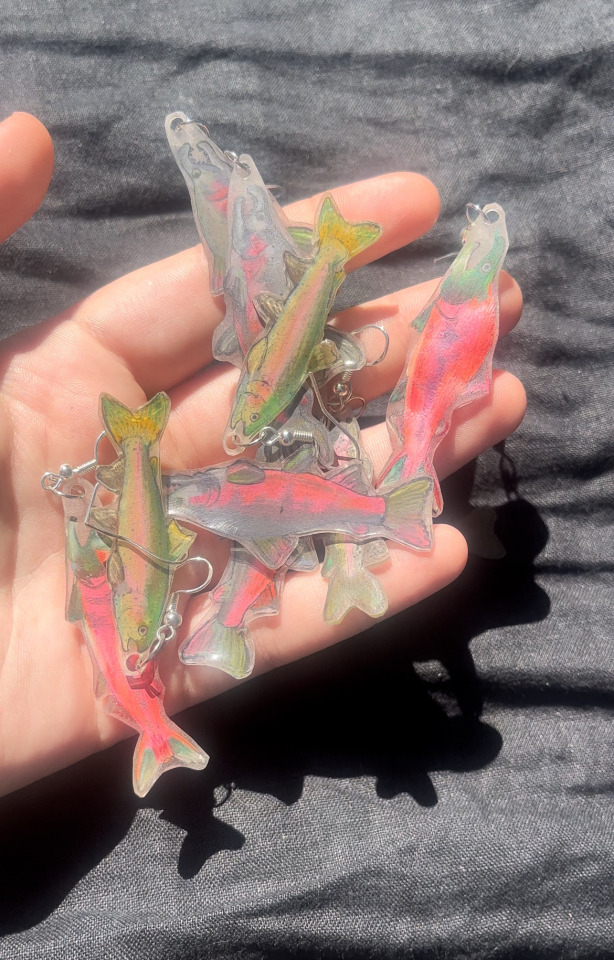
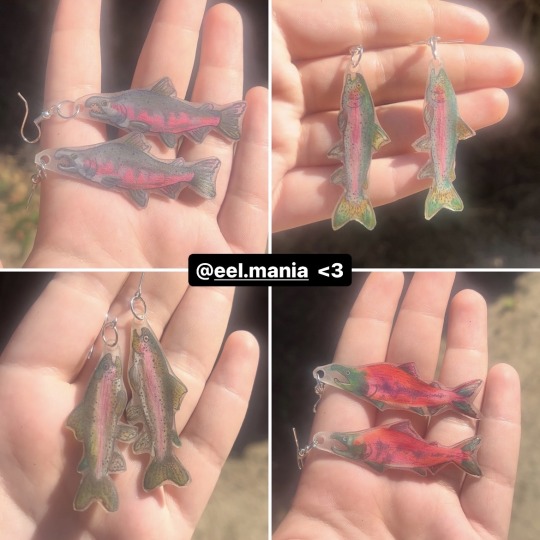
#salmon#rainbow trout#coho salmon#sockeye salmon#marine biology#marine bio#freshwater fish#fish#fish lover#etsyshop#etsyseller#small business#jewlery#there are many benefits to being a marine biologist#fishposting#queer artist#lgbtq artist#bony fish#fishblr#post#earrings#handmade#artists on etsy#etsyhandmade#fish enthusiast
126 notes
·
View notes
Text

Paleovember 2023, Xiphactinus!
Also known as the X-fish or the Bulldog fish, Xiphactinus swam the Western Interior Seaway during the Late Cretaceous, and was probably one of the most terrifying fish to ever exist. Not only did it grow up to 20 feet long, it turns out to have an attitude as ugly as it's face; specimens have been found having choked to death on fish way too large for their gullets, and it's likely that their own kind would have been on the menu as well.
#Xiphactinus#western interior seaway#fish#sea monster#late cretaceous#mesozoic#bony fish#paleontology#paleoart#art challenge#animal#illustration#art#artwork#digitalart#creaturedesign#procreate#artist on tumblr
60 notes
·
View notes
Text
BIG FUCKING FISH 3.


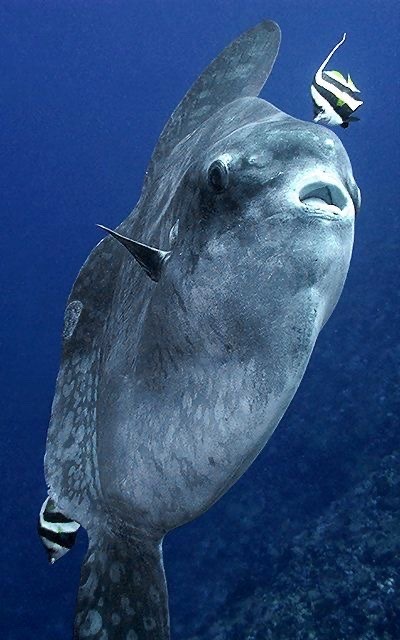
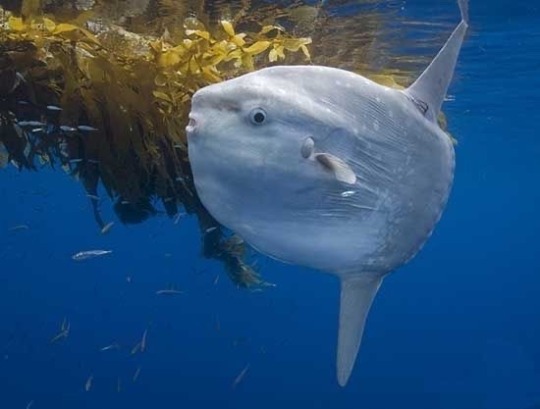
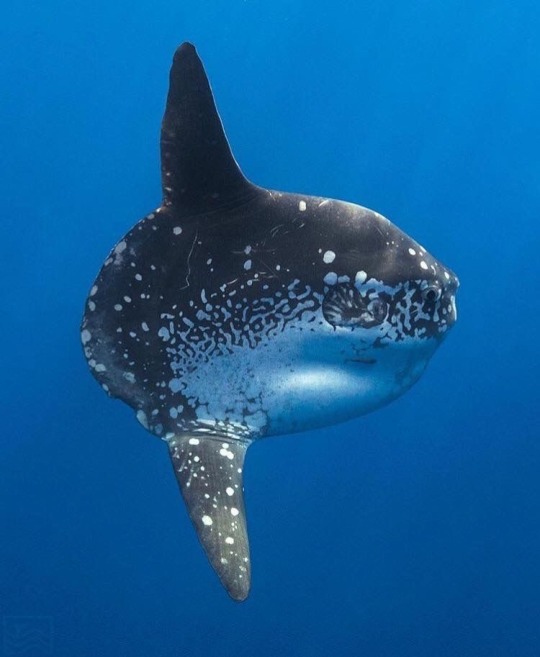
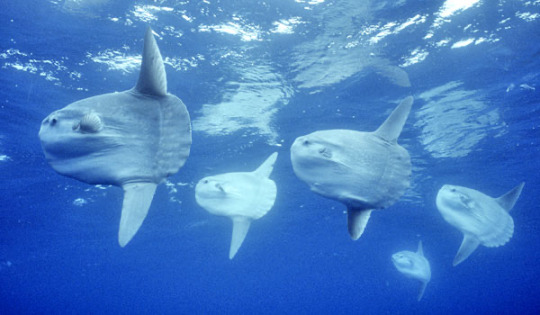

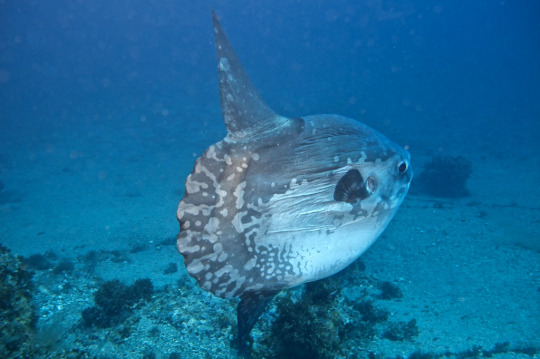

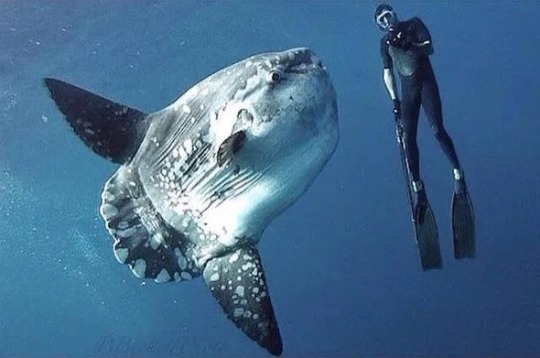
ocean sunfish - mola mola
#i love them so much u don’t understand#looking at these guys makes me want to cry#im in love with their character design#mola mola#sunfish#ocean sunfish#marine animals#marine biology#bony fish#big fucking fish#freak (affectionate)
60 notes
·
View notes
Text
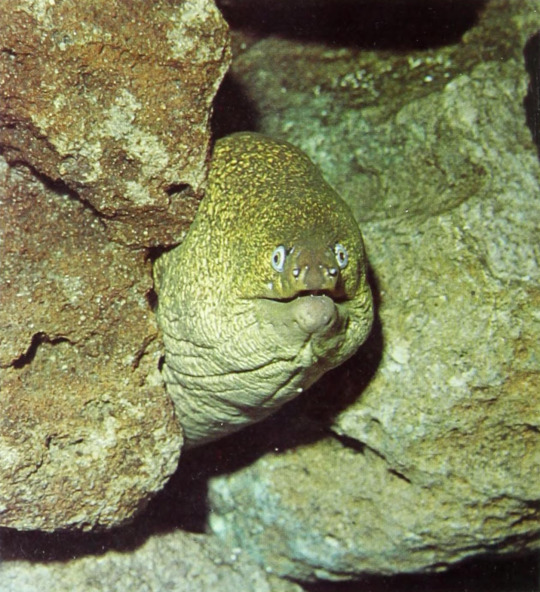
Moray eel
By: T. Stack
From: The Complete Encyclopedia of the Animal World
1980
#moray eel#eel#bony fish#fish#1980#1980s#T. Stack#The Complete Encyclopedia of the Animal World (1980)
5K notes
·
View notes
Text
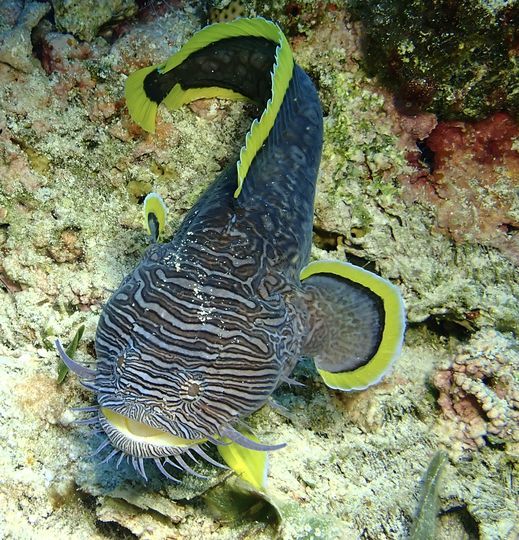
Splendid Toadfish (Sanopus splendidus), family Batrachoididae, order Batrachoidiformes, Cozumel, Mexico
ENDANGERED.
This fish has a buzzing mating call, which human divers can hear underwater.
photograph by Randy Lawson
#toadfish#sanopus#batrachoididae#batrachoidiformes#fish#bony fish#ichthyology#ocean#mexico#animals#nature
1K notes
·
View notes
Text

Sciartober Day 31: And the last one goes to the owlfish for the prompt: dark. There are only video reference for this animal along with a few illustrations, but I wanted to do something from one of MBARI's videos. I corrected the forehead to be less sloped, though the mouth might still be too big for this particular fish. Pentel brushpen, Windsor & Newton fine-line marker, and Prismacolor fine-line marker on Canson mixed media.
#Sciartober#Sciartober 2023#SciartoberDay31#deep sea#MBARI#owlfish#fish#animal#Bathylagidae#Osteichthyes#bony fish#art#my art#sciart#October drawings#October drawings 2023#pen and ink#black and white
28 notes
·
View notes
Text

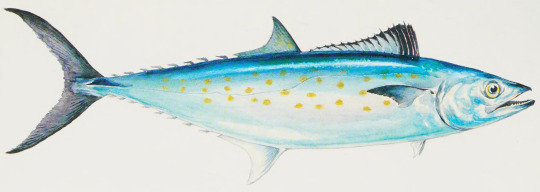

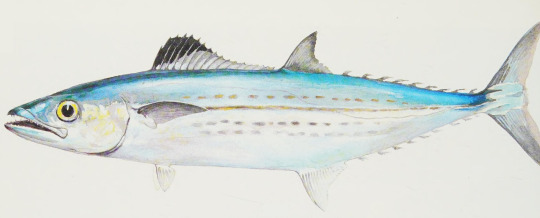
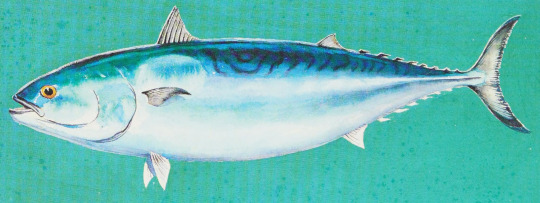
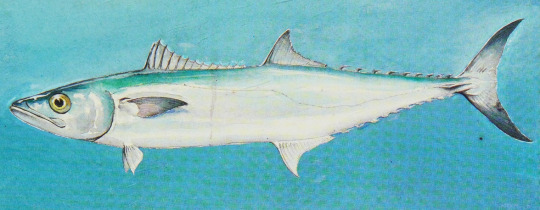
An Artist's Catch: Watercolors by Frank Stick (1884-1966). Edited by David Stick. Published in 1981.
Internet Archive
1.) Atlantic mackerel (Scomber scombrus)
2.) Atlantic Spanish mackerel (Scomberomorus maculatus)
3.) Chub mackerel (Scomber japonicus)
4.) Cero mackerel (Scomberomorus regalis)
5.) Frigate tuna (Auxis thazard)
6.) King mackerel (Scomberomorus cavalla)
#marine life#fish#bony fish#mackerel#atlantic mackerel#atlantic spanish mackerel#chub mackerel#cero mackerel#king mackerel#tunas#frigate tuna#Frank Stick
1K notes
·
View notes
Text
Uncharismatic Fact of the Day
Though they may look unassuming, brown trout are actually one of the most diverse vertebrates in the world! Populations and individuals can look wildly different from each other, to the point where many groups were often mislabeled as entirely separate species, and they have a remarkable ability to adapt to any environment. In fact, there is more genetic diversity between populations of British brown trout than there is between any population of the human race.
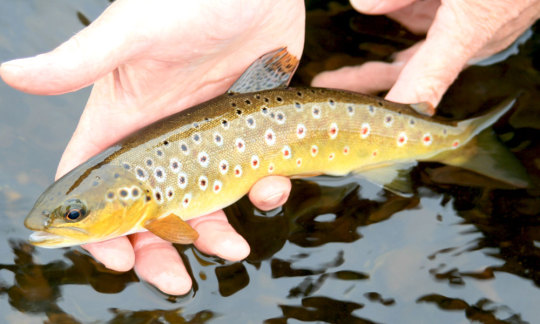


(Images: Three morphs of brown trout (Salmo trutta) by Eric Engbretson, David Miller and Jon Beer)
#brown trout#Salmoniformes#Salmonidae#trout#salmonids#ray finned fish#bony fish#fish#uncharismatic facts
317 notes
·
View notes